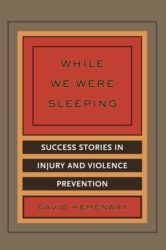A powerful book about injury prevention, a topic very near to my heart, has inspired me to speak out during this political season when we are hearing a lot of rhetoric about too much regulation, the “nanny state,” individual rights to not buckle up or wear a motorcycle helmet, or even not supporting public funding of essential things such as repair of highway bridges.
While We Were Sleeping: Success Stories in Injury and Violence Prevention, by David Hemenway of the Harvard Injury Control Research Center, presents a highly readable account of many successful efforts to protect people by preventing unintentional injuries and violence. It is his “personal ode to public health,” particularly injury prevention, which has fascinated him since the 1960s, when he worked for Ralph Nader and Consumers Union. He wants to explain the importance of public health because “most people do not recognize, or do not readily recall, when they personally have benefitted from a public health intervention.”
The first topic he addresses is the car, providing a concise history (only 21 pages of easy-to-read prose) of how vehicles and roadways have become safer and how regulations and laws have contributed substantially to saving lives and public money. Child passenger safety is one of the preventive efforts featured for the remarkable effectiveness it has had. (I’m pleased to find that Safe Ride News is given as a reference in at least two instances.) He also tells the stories behind other effective efforts, such as raising the minimum age for alcohol consumption, incorporating energy-absorbing steering columns into vehicles, and installing breakaway light posts.
Each chapter includes a few key “heroes” in the injury prevention field to represent the pioneers who have benefited all of us. As Hemenway says, often the actions of individuals are at least as important as governmental agencies or large organizations. Two of the seven heroes highlighted in the car chapter are pediatricians Dr. Seymour Charles and Dr. Robert Sanders, men who were catalysts for the early developments in child passenger protection, right up there with other auto safety greats Col. John Stapp and Ralph Nader. Who are the other three? Hugh DeHaven, William Haddon, and Candy Lightner. Who are they? Maybe it’s time to read the book.
Hemenway gives many fascinating examples of injury prevention measures in other settings in which serious injuries commonly occur, such as in the home, during natural catastrophes, and during play. He highlights some heroes we all know, such as Benjamin Franklin (for the lightning rod) and Father Edward Flanagan (for Boys Town and violence prevention) and others whom very few of us have heard of. He makes clear that he is only giving readers examples—volumes would have to be written to tell the full story of auto safety or even child passenger protection alone.
I firmly believe in the importance of regulations—when backed up by accurate science and not distorted by industry or other special interests. Regulations to control significant hazards are needed for the good of all members of our community. It is not only the obviously powerless ones, such as children, who need protection. As individuals, we can be powerless against corporations who choose to make decisions that have disastrous long-term health consequences. Some of the people in power today seem to have forgotten about responsibility to the common good in their zest for limiting or eliminating whatever has been done in the name of protecting people. Developing useful, necessary regulations and other prevention efforts depends on the understanding and support of individual citizens.
We, who are deeply immersed in child passenger safety, can help by speaking out for those who can be saved, or may never even realize they were “saved,” by the larger efforts of public health.
—Deborah Davis Stewart
Reference:
Hemenway, David. While We Were Sleeping: Success Stories in Injury and Violence Prevention. University of California Press, 2009.

